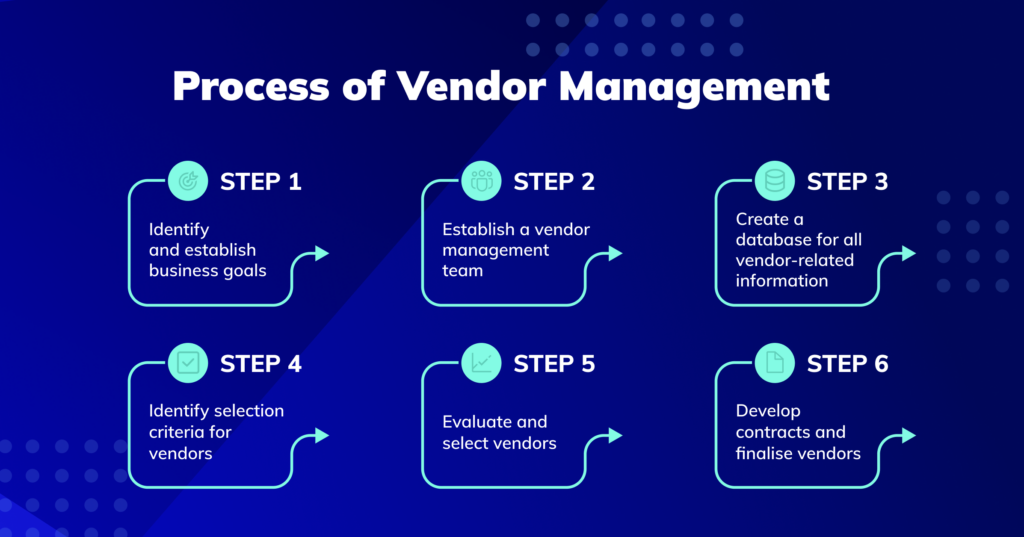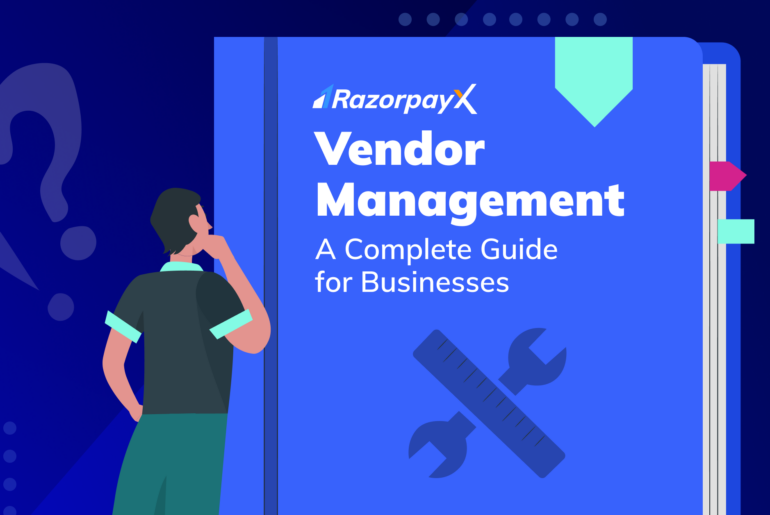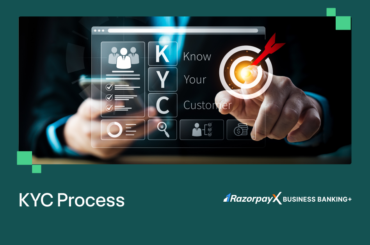Table of Contents
What is Vendor Management?
Vendor management is the management of third-party suppliers who provide goods and services to a business. Vendor management includes activities like vendor selection, cost control, budgeting, invoice management, contract management, etc.
Each business has unique needs which are fulfilled by a unique set of vendors. For an IT company, vendors provide laptops, cloud hosting services, etc. A bakery’s vendors could include flour merchants, machinery rental vendors, etc.
Managing vendors is a complex, multi-facted process involving multiple stakeholders. Most businesses today use automated processes and software like RazorpayX Source to Pay to manage vendors with ease.
What is a Vendor Management System (VMS)?
A Vendor Management System is software that helps businesses automate and digitize their vendor management processes. VMS helps businesses with the entire process of vendor management:
- Identifying and selecting vendors
- Onboarding vendors into the system
- Tracking vendor deliveries with PRs, POs, GRNs and Invoices
- Making payments to vendors on time and accurately
- Reconciling payments with books of accounts
- Managing vendor contracts and other documents
VMS is only part of the Source to Pay suite. The procurement process is a much larger, complex process. With the innovations of today, businesses can customize their software of choice to fit their procurement requirements.
Explore RazorpayX Source to Pay
Importance of Vendor Management
Managing vendors well is important because it helps the business maintain good relationships with the vendors, which in turn brings benefits like flexible repayment terms, longer credit periods, better quality products or services, etc.
Good vendor relations can also mean discounts, cost savings, early deliveries and more. It also improves the entire supply chain and gives better options to deal with disruptions to the process.
What does good vendor management look like?
- Well-defined deliverables and KPIs, agreed upon by both parties – this is an important first step in establishing a good relationship with your vendors
- Clear communication with your vendor on your requirements, policies, feedback, etc. This ensures transparency and opportunities for improvement
- Proactively identify and mitigate risks associated with vendors, such as financial instability, quality issues, or security breaches
- Leverage data to gain insights into vendor performance and identify areas for improvement
Vendor Management Process
The vendor management process includes various activities.
 1. Identify & establish business goals
1. Identify & establish business goals
Before starting a vendor management process, it is vital to identify and establish business goals that necessitate the involvement of a vendor.
This helps understand the needs of all business units and prevents wastage of resources and duplication of efforts in contracting and choosing vendors. Also, it helps you in the later stages of assessing and evaluating vendor performance. And that’s because these goals establish suitable metrics.
2. Establish a vendor management team
After recognising business goals, a dedicated vendor management team should be your next step. This centralised team must be skilled to:
- Identify KPIs for vendor management and business goals
- Select relevant vendors
- Negotiate the contracting process
- Assess the performance of vendors periodically
- Track every transaction activity
This team will act as an intermediary between the vendors and business units and ensure collaboration.
Additionally, it will prevent the engagement of too many stakeholders.
On the contrary, if you don’t have a dedicated team, it can result in disparate transactions with multiple vendors or a huge number of contracts with the same vendor. This impedes the evaluation and tracking of vendor performance and exposes the company to vendor risk.
3. Create a database for all vendor-related information
After a vendor management team is up and running and business goals are clear, building a categorised and updated database of all relevant vendor-related information should be the next step.
There are several advantages of this, including:
- Cross-vendor comparison becomes easier for evaluation after categorising vendors based on their type.
- It streamlines information. Hence, disparate, scattered vendor information gets stored in a single location and offers insights into the present stage of the vendors.
- It enables effective budgeting. Thus, individuals can easily recognise the long-term vendors and the tactical, short-term vendors and accordingly assess the budget assignment.
- It matches the requirements of business units to an appropriate vendor. For instance, the administration can identify the relevant vendors for computer equipment, office supplies, etc.
4. Identify selection criteria for vendors
After all the vendor information is updated, categorised, and streamlined, you need to choose the criteria depending on which relevant vendor will be selected. The cost has been a primary criterion for the selection to choose vendors. Still, businesses can look at other criteria, such as past work, etc., to determine which vendor will serve their requirements in the best way.
5. Evaluate and select vendors
In this stage, vendors must be evaluated depending on the selection criteria and bidding procedure, if applicable.
The submitted proposals must be assessed thoroughly to understand the scope of work, how the requirements will be met, pricing structure, expiry and renewal dates, terms and conditions, etc.
This will help ensure that the company derives maximum value from a vendor.
You must assess the internal weaknesses and strengths of vendors and study how the external threats and opportunities can impact your transaction and vendor management procedure.
After ensuring a complete start-to-finish evaluation procedure, you should look forward to choosing a vendor.
6. Develop contracts and finalise vendors
Now you have selected a vendor, it is time to finish the contracting procedure and get vendors on board. Ideally, the contracting stage is assigned to the senior management linked with the vendors, finance, and legal team. The remaining business units receive the contract and get involved with vendors after the finalisation procedure.
Vendor Management Challenges Faced by Small Businesses
Small businesses have a unique set of problems when it comes to vendor management. Let’s look at some of them briefly:
Problems faced by small business owners
1. Not enough technical knowledge
An early-age startup’s priorities differ from an enterprise. Rather than having a dedicated vendor management team, they might involve their finance team or other relevant stakeholders in vendor management processes such as vendor selection, vendor payments etc.
A significant part of vendor management is vendor payments i.e., paying the vendors after they have provided their services. While doing vendor payments, you need to deduct TDS (tax deducted at source) for vendors. As a small business owner, you must know about the TDS rate chart and payment category if you’re doing vendor payments on your own.
Additionally, small businesses need to claim the input tax credit for the GST payments made by them. All this can be very daunting, especially for someone doing it for the first time. So, not having enough knowledge of the vendor payments process becomes a significant problem for small businesses.
2. Managing vendor invoices manually
Here’s what the usual process of managing vendor invoices looks like when doing it manually:
Step 1: Invoice is received in the email
Step 2: Usually multiple invoices are sorted into folders so the invoice received is shifted to its relevant folder on the system
Step 3: Further, an Excel sheet is maintained and an entry of the invoice is made into it for tracking
Step 4: Then, as mentioned above, TDS to be deducted is calculated and deducted accordingly
Step 5: After this payment is made through portals
Step 6: Finally, manual reconciliation of vendor payment done
3. Information on email
Generally, a lot of email back and forth and follow-ups happen with vendors. You also require vendor bank account details, IFSC code, and other such details while handling payments to vendors. As a small business owner, you have a lot on your plate, and you want to minimise vendor communication as much as possible.
All of this can be very daunting, especially for someone doing it for the first time. This is when vendor management systems come into the picture and save the day.
Features of Vendor Management System
Vendor Lifecycle Management:
-
- Streamlined onboarding of new vendors
- Centralized contract storage and management
- Performance tracking with customizable KPIs
- Efficient offboarding process
Automation and Efficiency:
-
-
- Automated workflows for repetitive tasks (purchase orders, invoices, reports)
- Centralized communication platform with vendors
- Data analysis and reporting for insights and cost savings
-
Additional Features:
-
- Integrates with existing ERP, procurement, or accounting systems
- Secure storage of vendor data and regulatory compliance tools
- Customization options to fit specific needs and workflows
Related Read: What is the Difference Between Purchase Orders and Invoices?
Manage vendors easily and automate manual tasks with RazorpayX
RazorpayX Vendor Payments automates all the manual tasks in vendor payments and turns the aforementioned multi-step process into just one-step process. It also offers Vendor Portal–a vendor-facing platform that enables vendors to submit bank details, invoices, and track invoices.
This portal enables you to send a vendor-facing portal request to concerned vendors. After that, the vendors can upload their invoices and track payments.
With RazorpayX Vendor Payments, you can:
- Add invoices and track vendor payments, the easy way
- Say goodbye to manual data entry.
- Simply add the TDS category to your vendors, and it auto-calculates, deducts and pays TDS for every invoice
And more!
Don’t believe us? Sign up on RazorpayX and see for yourself. Our forever free plan covers 300 vendor payments per month.
Read more
FAQs
What do you mean by vendor relationship management?
Vendor information management is used to update, analyse, capture and store vendor data. On the other hand, vendor relationship management refers to the system which allows for seamless communication between the vendor and buyer and the formation of a more productive partnership. The two procedures are generally connected, and the same software handles them. That’s why it is often used interchangeably.
How does the vendor management system work?
A vendor management system is software that helps organisations manage vendor management procedures end-to-end. This starts from the initial contract to a deal’s final closure. For more details refer to the blog post.
What are the benefits of using a vendor management system?
Vendor management systems (VMS) offer several benefits that can streamline your business operations and strengthen your vendor relationships. Here's a concise rundown in three sentences: VMS automates tasks like onboarding, invoicing, and reporting, freeing up your team's time and reducing errors. It also centralizes communication and performance tracking, fostering better collaboration with vendors. Overall, VMS helps you achieve cost savings, improve efficiency, and build stronger partnerships with your suppliers.
What are the stages of a vendor management process?
The vendor management journey starts with defining your needs and selecting the best vendor. Next, you onboard them efficiently and track their performance against set benchmarks. Throughout the relationship, you build trust through communication and collaboration, while proactively managing risks.
What are the factors you should consider when choosing a vendor management system?
Selecting a VMS hinges on three factors: understanding your needs (onboarding, automation, etc.), ensuring scalability to fit future growth, and verifying smooth integration with your existing business systems.





